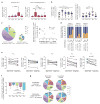HIV-1 persistence in CD4+ T cells with stem cell-like properties
- PMID: 24412925
- PMCID: PMC3959167
- DOI: 10.1038/nm.3445
HIV-1 persistence in CD4+ T cells with stem cell-like properties
Abstract
Cellular HIV-1 reservoirs that persist despite antiretroviral treatment are incompletely defined. We show that during suppressive antiretroviral therapy, CD4(+) T memory stem cells (TSCM cells) harbor high per-cell levels of HIV-1 DNA and make increasing contributions to the total viral CD4(+) T cell reservoir over time. Moreover, we conducted phylogenetic studies that suggested long-term persistence of viral quasispecies in CD4(+) TSCM cells. Thus, HIV-1 may exploit the stem cell characteristics of cellular immune memory to promote long-term viral persistence.
Figures


Comment in
-
Long-lived reservoirs of HIV-1.Trends Microbiol. 2014 Apr;22(4):173-5. doi: 10.1016/j.tim.2014.02.015. Epub 2014 Mar 15. Trends Microbiol. 2014. PMID: 24641995 Free PMC article.
References
-
- Finzi D, et al. Latent infection of CD4+ T cells provides a mechanism for lifelong persistence of HIV-1, even in patients on effective combination therapy. Nat Med. 1999;5:512–517. - PubMed
-
- Sallusto F, Lenig D, Forster R, Lipp M, Lanzavecchia A. Two subsets of memory T lymphocytes with distinct homing potentials and effector functions. Nature. 1999;401:708–712. - PubMed
-
- Lanzavecchia A, Sallusto F. Progressive differentiation and selection of the fittest in the immune response. Nat Rev Immunol. 2002;2:982–987. - PubMed
-
- Fearon DT, Manders P, Wagner SD. Arrested differentiation, the self-renewing memory lymphocyte, and vaccination. Science. 2001;293:248–250. - PubMed
Publication types
MeSH terms
Substances
Grants and funding
- K08 AI100699/AI/NIAID NIH HHS/United States
- R21 AI106468/AI/NIAID NIH HHS/United States
- AI098480/AI/NIAID NIH HHS/United States
- AI106468/AI/NIAID NIH HHS/United States
- AI100699/AI/NIAID NIH HHS/United States
- P01 AI074415/AI/NIAID NIH HHS/United States
- AI089339/AI/NIAID NIH HHS/United States
- AI098487/AI/NIAID NIH HHS/United States
- AI074415/AI/NIAID NIH HHS/United States
- K23 AI098480/AI/NIAID NIH HHS/United States
- R01 AI089339/AI/NIAID NIH HHS/United States
- HHMI/Howard Hughes Medical Institute/United States
- R01 AI098487/AI/NIAID NIH HHS/United States
LinkOut - more resources
Full Text Sources
Other Literature Sources
Medical
Molecular Biology Databases
Research Materials

